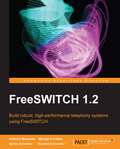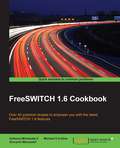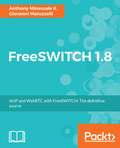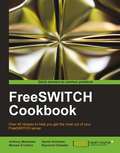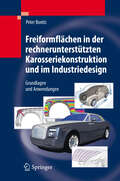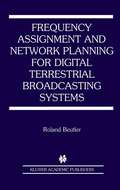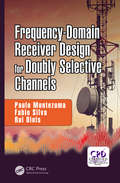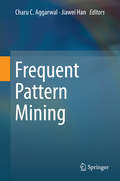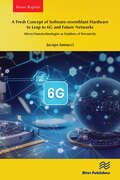- Table View
- List View
FreeSWITCH 1.2
by Anthony Minessale Michael S Collins Darren Schreiber Raymond ChandlerThis book is full of practical code examples aimed at a beginner to ease his or her learning curve.This book is written for IT professionals and enthusiasts who are interested in quickly getting a powerful telephony system up and running using the free and open source application, FreeSWITCH.Telephony experience will be helpful, but not required.
FreeSWITCH 1.6 Cookbook
by Anthony Minessale II Michael S Collins Giovanni MaruzzelliFreeSWITCH 1.6 Cookbook is written for anyone who wants to learn more about using FreeSWITCH in production. The information is presented in such a way that you can get up and running quickly. The cookbook approach eschews much of the foundational concepts, and instead focuses on discrete examples that illustrate specific features. If you need to implement a particular feature as quickly as possible, then this book is for you.
FreeSWITCH 1.8
by Anthony Minessale II Giovanni MaruzzelliBuild a robust, high-performance telephony system with FreeSWITCH About This Book • Learn how to install and configure a complete telephony system of your own, from scratch, using FreeSWITCH 1.6 • Get in-depth discussions of important concepts such as dialplan, user directory, NAT handling, and the powerful FreeSWITCH event socket • Discover expert tips from the FreeSWITCH experts, including the creator of FreeSWITCH—Anthony Minessale Who This Book Is For This book is for beginner-level IT professionals and enthusiasts who are interested in quickly getting a powerful telephony system up and running using FreeSWITCH. It would be good if you have some telephony experience, but it's not a must. What You Will Learn • Build a complete WebRTC/SIP VoIP platform able to interconnect and process audio and video in real time • Use advanced PBX features to create powerful dialplans • Understand the inner workings and architecture of FreeSWITCH • Real time configuration from database and webserver with mod_xml_curl • Integrate browser clients into your telephony service • Use scripting to go beyond the dialplan with the power and flexibility of a programming language • Secure your FreeSWITCH connections with the help of effective techniques • Deploy all FreeSWITCH features using best practices and expert tips • Overcome frustrating NAT issues • Control FreeSWITCH remotely with the all-powerful event socket • Trace packets, check debug logging, ask for community and commercial help In Detail FreeSWITCH is an open source telephony platform designed to facilitate the creation of voice and chat-driven products, scaling from a soft-phone to a PBX and even up to an enterprise-class soft-switch. This book introduces FreeSWITCH to IT professionals who want to build their own telephony system. This book starts with a brief introduction to the latest version of FreeSWITCH. We then move on to the fundamentals and the new features added in version 1.6, showing you how to set up a basic system so you can make and receive phone calls, make calls between extensions, and utilize basic PBX functionality. Once you have a basic system in place, we'll show you how to add more and more functionalities to it. You'll learn to deploy the features on the system using unique techniques and tips to make it work better. Also, there are changes in the security-related components, which will affect the content in the book, so we will make that intact with the latest version. There are new support libraries introduced, such as SQLite, OpenSS, and more, which will make FreeSWITCH more efficient and add more functions to it. We'll cover these in the new edition to make it more appealing for you. Style and approach This easy-to-follow guide helps you understand every topic easily using real-world examples of FreeSWITCH tasks. This book is full of practical code so you get a gradual learning curve.
FreeSWITCH Cookbook
by Anthony MinessaleThis is a problem-solution approach to take your FreeSWITCH skills to the next level, where everything is explained in a practical way. If you are a system administrator, hobbyist, or someone who uses FreeSWITCH on a regular basis, this book is for you. Whether you are a FreeSWITCH expert or just getting started, this book will take your skills to the next level.
Freiformflächen in der rechnerunterstützten Karosseriekonstruktion und im Industriedesign: Grundlagen und Anwendungen
by Peter BonitzDer Entwicklungsprozess von der Designidee bis zum Werkzeug für die Blechumformung im Karosseriebau verlangt ein solides Verständnis der CAD-Technologien. Deshalb geht der Autor weit über die Beschreibung grundlegender Fähigkeiten zur Bedienung von CAD-Systemen hinaus und vermittelt mathematische Grundlagen sowie deren Einsatz bei der Gestaltung. Das Buch wendet sich an Entwickler von CAD-Anwendungen, an Designer, Konstrukteure und Werkzeugbauer (Automotive, Maschinenbau, Luft- und Raumfahrt), die frei geformte Oberflächen gestalten.
The French Language in the Digital Age (White Paper Series)
by Georg Rehm Hans UszkoreitThis white paper is part of a series that promotes knowledge about language technology and its potential. It addresses educators, journalists, politicians, language communities and others. The availability and use of language technology in Europe varies between languages. Consequently, the actions that are required to further support research and development of language technologies also differ for each language. The required actions depend on many factors, such as the complexity of a given language and the size of its community. META-NET, a Network of Excellence funded by the European Commission, has conducted an analysis of current language resources and technologies. This analysis focused on the 23 official European languages as well as other important national and regional languages in Europe. The results of this analysis suggest that there are many significant research gaps for each language. A more detailed expert analysis and assessment of the current situation will help maximise the impact of additional research and minimize any risks. META-NET consists of 54 research centres from 33 countries that are working with stakeholders from commercial businesses, government agencies, industry, research organisations, software companies, technology providers and European universities. Together, they are creating a common technology vision while developing a strategic research agenda that shows how language technology applications can address any research gaps by 2020.
The French School of Programming
The French School of Programming is a collection of insightful discussions of programming and software engineering topics, by some of the most prestigious names of French computer science. The authors include several of the originators of such widely acclaimed inventions as abstract interpretation, the Caml, OCaml and Eiffel programming languages, the Coq proof assistant, agents and modern testing techniques.The book is divided into four parts: Software Engineering (A), Programming Language Mechanisms and Type Systems (B), Theory (C), and Language Design and Programming Methodology (D). They are preceded by a Foreword by Bertrand Meyer, the editor of the volume, a Preface by Jim Woodcock providing an outsider’s appraisal of the French school’s contribution, and an overview chapter by Gérard Berry, recalling his own intellectual journey. Chapter 2, by Marie-Claude Gaudel, presents a 30-year perspective on the evolution of testing starting with her own seminal work. In chapter 3, Michel Raynal covers distributed computing with an emphasis on simplicity. Chapter 4, by Jean-Marc Jézéquel, former director of IRISA, presents the evolution of modeling, from CASE tools to SLE and Machine Learning. Chapter 5, by Joëlle Coutaz, is a comprehensive review of the evolution of Human-Computer Interaction. In part B, chapter 6, by Jean-Pierre Briot, describes the sequence of abstractions that led to the concept of agent. Chapter 7, by Pierre-Louis Curien, is a personal account of a journey through fundamental concepts of semantics, syntax and types. In chapter 8, Thierry Coquand presents “some remarks on dependent type theory”. Part C begins with Patrick Cousot’s personal historical perspective on his well-known creation, abstract interpretation, in chapter 9. Chapter 10, by Jean-Jacques Lévy, is devoted to tracking redexes in the Lambda Calculus. The final chapter of that part, chapter 11 by Jean-Pierre Jouannaud, presents advances in rewriting systems, specifically the confluence of terminating rewriting computations. Part D contains two longer contributions. Chapter 12 is a review by Giuseppe Castagna of a broad range of programming topics relying on union, intersection and negation types. In the final chapter, Bertrand Meyer covers “ten choices in language design” for object-oriented programming, distinguishing between “right” and “wrong” resolutions of these issues and explaining the rationale behind Eiffel’s decisions.This book will be of special interest to anyone with an interest in modern views of programming — on such topics as programming language design, the relationship between programming and type theory, object-oriented principles, distributed systems, testing techniques, rewriting systems, human-computer interaction, software verification… — and in the insights of a brilliant group of innovators in the field.
Frequency Assignment and Network Planning for Digital Terrestrial Broadcasting Systems (Ercoftac Ser.)
by Roland BeutlerFrequency Assignment and Network Planning for Digital Terrestrial Broadcasting Systems focuses on Digital Audio Broadcasting and Digital Video Broadcasting. The author provides a concise introduction to the subject and presents principles, concepts and commonly accepted methods used in the planning process. The frequency assignment material focuses on allotment planning while network planning is dealt with mainly from a network optimization perspective. All methods introduced and mathematical tools presented are fully explained. General concepts are illustrated with the help of several planning scenarios both for frequency assignment and network planning. Frequency assignment and network planning are vital issues throughout most of Europe and North America as a direct consequence of the increasing demand for digital communication systems.
Frequency-Domain Receiver Design for Doubly Selective Channels
by Paulo Montezuma Fabio Silva Rui DinisFrequency-Domain Receiver Design for Doubly-Selective Channels discusses broadband wireless transmission techniques, which are serious candidates to be implemented in future broadband wireless and cellular systems, aiming at providing high and reliable data transmission and concomitantly high mobility. This book provides an overview of the channel impairments that may affect performance of single carrier and multi-carrier block transmission techniques in mobile environments. Moreover, it also provides a new insight into the new receiver designs able to cope with double selectivity that affects present and future broadband high speed mobile communication systems.
Frequency-Domain Receiver Design for Doubly Selective Channels
by Fabio Silva Paulo Montezuma Rui DinisFrequency-Domain Receiver Design for Doubly-Selective Channels discusses broadband wireless transmission techniques, which are serious candidates to be implemented in future broadband wireless and cellular systems, aiming at providing high and reliable data transmission and concomitantly high mobility. This book provides an overview of the channel impairments that may affect performance of single carrier and multi-carrier block transmission techniques in mobile environments. Moreover, it also provides a new insight into the new receiver designs able to cope with double selectivity that affects present and future broadband high speed mobile communication systems.
Frequent Pattern Mining
by Charu C. Aggarwal Jiawei HanThis comprehensive reference consists of 18 chapters from prominent researchers in the field. Each chapter is self-contained, and synthesizes one aspect of frequent pattern mining. An emphasis is placed on simplifying the content, so that students and practitioners can benefit from the book. Each chapter contains a survey describing key research on the topic, a case study and future directions. Key topics include: Pattern Growth Methods, Frequent Pattern Mining in Data Streams, Mining Graph Patterns, Big Data Frequent Pattern Mining, Algorithms for Data Clustering and more. Advanced-level students in computer science, researchers and practitioners from industry will find this book an invaluable reference.
A Fresh Concept of Software-resemblant Hardware to Leap to 6G and Future Networks: Micro/Nanotechnologies as Enablers of Pervasivity
by Jacopo IannacciFor a decade, with the uptake of 4G, we have become accustomed to the relentless increase in data and services on the move. The deployment of 5G is advancing crucial key performance indicators (KPIs), along with quality of service (QoS). Setting the horizon to 2030 and later, 6G will take the KPIs to numbers 100–1000 times better than 5G. Yet, the actual disruption of 6G and future networks (FN) will take place following other unprecedented paths.Artificial intelligence (AI) will be exploited in a threadlike fashion, at any level of the network physical infrastructure. This will introduce, to date unknown features, like self-sustaining, self-evolution and high-resilience of small portions of the infrastructure, pioneering the concept of a network of networks. Each segment of the infrastructure will bear a high degree of independence, while working at the same time as a whole, in full orchestration with the rest of the network.Given such a scenario, this book claims that the established and currently in use paradigms for the design and development of hardware–software (HW–SW) systems, are not appropriate to address the challenges of 6G and, further ahead, of FN. In response, unprecedented design approaches are suggested, relying on a fresh reinterpretation of the standard concept of HW, with specific attention to the network edge and edge intelligence (EI).This work develops some conceptual tools that may help address the technical challenges resulting from the intricate scenario sketched above. Within the mentioned HW reconceptualization, a pivotal role is forecasted for microtechnologies and nanotechnologies, intended with a broad meaning, which embraces, among others, devices, systems (MEMS/NEMS) and materials.
A Fresh Concept of Software-resemblant Hardware to Leap to 6G and Future Networks: Micro/Nanotechnologies as Enablers of Pervasivity
by Jacopo IannacciFor a decade, with the uptake of 4G, we have become accustomed to the relentless increase in data and services on the move. The deployment of 5G is advancing crucial key performance indicators (KPIs), along with quality of service (QoS). Setting the horizon to 2030 and later, 6G will take the KPIs to numbers 100–1000 times better than 5G. Yet, the actual disruption of 6G and future networks (FN) will take place following other unprecedented paths.Artificial intelligence (AI) will be exploited in a threadlike fashion, at any level of the network physical infrastructure. This will introduce, to date unknown features, like self-sustaining, self-evolution and high-resilience of small portions of the infrastructure, pioneering the concept of a network of networks. Each segment of the infrastructure will bear a high degree of independence, while working at the same time as a whole, in full orchestration with the rest of the network.Given such a scenario, this book claims that the established and currently in use paradigms for the design and development of hardware–software (HW–SW) systems, are not appropriate to address the challenges of 6G and, further ahead, of FN. In response, unprecedented design approaches are suggested, relying on a fresh reinterpretation of the standard concept of HW, with specific attention to the network edge and edge intelligence (EI).This work develops some conceptual tools that may help address the technical challenges resulting from the intricate scenario sketched above. Within the mentioned HW reconceptualization, a pivotal role is forecasted for microtechnologies and nanotechnologies, intended with a broad meaning, which embraces, among others, devices, systems (MEMS/NEMS) and materials.
Fresh Flash: New Design Ideas with Flash MX
by Brandon Williams Jared Tarbell Paul Prudence Keith Peters Ty Lettau Danny Franzreb Jim Armstrong JD HoogeSo you think you've got to grips with the features of Macromedia Flash MX? Welcome to this inspirations upgrade from friends of ED. Upgrade your thinking, upgrade your attitude, and upgrade your standards to take on board the host of exciting features incorporated into this version of Flash. With this title, we run the gamut of new features, from the Drawing API ("to die for"), through new video compression, Scriptable Masks and Components. We explore the new territory with experimental interfaces, check out the improvements in the 3D arena, and quarry the back-end technologies to see what gems we can turn up! Some of the best designers in the Web community have concentrated their efforts on this project. This has resulted in the highest caliber of work, including an exclusive insight into the creation of Jim Armstrong's New York Flash Film Festival final piece. From the acclaimed team that brought you Flash Math Creativity comes this inspiring volume, full of brand new effects and discussion on what Flash MX is going to do for designers—and where we go from here.
The Freudian Robot: Digital Media and the Future of the Unconscious
by Lydia H. LiuThe identity and role of writing has evolved in the age of digital media. But how did writing itself make digital media possible in the first place? Lydia H. Liu offers here the first rigorous study of the political history of digital writing and its fateful entanglement with the Freudian unconscious. Liu’s innovative analysis brings the work of theorists and writers back into conversation with one another to document significant meetings of minds and disciplines. She shows how the earlier avant-garde literary experiments with alphabetical writing and the word-association games of psychoanalysis contributed to the mathematical making of digital media. Such intellectual convergence, she argues, completed the transformation of alphabetical writing into the postphonetic, ideographic system of digital media, which not only altered the threshold of sense and nonsense in communication processes but also compelled a new understanding of human-machine interplay at the level of the unconscious. Ranging across information theory, cybernetics, modernism, literary theory, neurotic machines, and psychoanalysis, The Freudian Robot rewrites the history of digital media and the literary theory of the twentieth century.
The Freudian Robot: Digital Media and the Future of the Unconscious
by Lydia H. LiuThe identity and role of writing has evolved in the age of digital media. But how did writing itself make digital media possible in the first place? Lydia H. Liu offers here the first rigorous study of the political history of digital writing and its fateful entanglement with the Freudian unconscious. Liu’s innovative analysis brings the work of theorists and writers back into conversation with one another to document significant meetings of minds and disciplines. She shows how the earlier avant-garde literary experiments with alphabetical writing and the word-association games of psychoanalysis contributed to the mathematical making of digital media. Such intellectual convergence, she argues, completed the transformation of alphabetical writing into the postphonetic, ideographic system of digital media, which not only altered the threshold of sense and nonsense in communication processes but also compelled a new understanding of human-machine interplay at the level of the unconscious. Ranging across information theory, cybernetics, modernism, literary theory, neurotic machines, and psychoanalysis, The Freudian Robot rewrites the history of digital media and the literary theory of the twentieth century.
The Freudian Robot: Digital Media and the Future of the Unconscious
by Lydia H. LiuThe identity and role of writing has evolved in the age of digital media. But how did writing itself make digital media possible in the first place? Lydia H. Liu offers here the first rigorous study of the political history of digital writing and its fateful entanglement with the Freudian unconscious. Liu’s innovative analysis brings the work of theorists and writers back into conversation with one another to document significant meetings of minds and disciplines. She shows how the earlier avant-garde literary experiments with alphabetical writing and the word-association games of psychoanalysis contributed to the mathematical making of digital media. Such intellectual convergence, she argues, completed the transformation of alphabetical writing into the postphonetic, ideographic system of digital media, which not only altered the threshold of sense and nonsense in communication processes but also compelled a new understanding of human-machine interplay at the level of the unconscious. Ranging across information theory, cybernetics, modernism, literary theory, neurotic machines, and psychoanalysis, The Freudian Robot rewrites the history of digital media and the literary theory of the twentieth century.
The Freudian Robot: Digital Media and the Future of the Unconscious
by Lydia H. LiuThe identity and role of writing has evolved in the age of digital media. But how did writing itself make digital media possible in the first place? Lydia H. Liu offers here the first rigorous study of the political history of digital writing and its fateful entanglement with the Freudian unconscious. Liu’s innovative analysis brings the work of theorists and writers back into conversation with one another to document significant meetings of minds and disciplines. She shows how the earlier avant-garde literary experiments with alphabetical writing and the word-association games of psychoanalysis contributed to the mathematical making of digital media. Such intellectual convergence, she argues, completed the transformation of alphabetical writing into the postphonetic, ideographic system of digital media, which not only altered the threshold of sense and nonsense in communication processes but also compelled a new understanding of human-machine interplay at the level of the unconscious. Ranging across information theory, cybernetics, modernism, literary theory, neurotic machines, and psychoanalysis, The Freudian Robot rewrites the history of digital media and the literary theory of the twentieth century.
The Freudian Robot: Digital Media and the Future of the Unconscious
by Lydia H. LiuThe identity and role of writing has evolved in the age of digital media. But how did writing itself make digital media possible in the first place? Lydia H. Liu offers here the first rigorous study of the political history of digital writing and its fateful entanglement with the Freudian unconscious. Liu’s innovative analysis brings the work of theorists and writers back into conversation with one another to document significant meetings of minds and disciplines. She shows how the earlier avant-garde literary experiments with alphabetical writing and the word-association games of psychoanalysis contributed to the mathematical making of digital media. Such intellectual convergence, she argues, completed the transformation of alphabetical writing into the postphonetic, ideographic system of digital media, which not only altered the threshold of sense and nonsense in communication processes but also compelled a new understanding of human-machine interplay at the level of the unconscious. Ranging across information theory, cybernetics, modernism, literary theory, neurotic machines, and psychoanalysis, The Freudian Robot rewrites the history of digital media and the literary theory of the twentieth century.
The Freudian Robot: Digital Media and the Future of the Unconscious
by Lydia H. LiuThe identity and role of writing has evolved in the age of digital media. But how did writing itself make digital media possible in the first place? Lydia H. Liu offers here the first rigorous study of the political history of digital writing and its fateful entanglement with the Freudian unconscious. Liu’s innovative analysis brings the work of theorists and writers back into conversation with one another to document significant meetings of minds and disciplines. She shows how the earlier avant-garde literary experiments with alphabetical writing and the word-association games of psychoanalysis contributed to the mathematical making of digital media. Such intellectual convergence, she argues, completed the transformation of alphabetical writing into the postphonetic, ideographic system of digital media, which not only altered the threshold of sense and nonsense in communication processes but also compelled a new understanding of human-machine interplay at the level of the unconscious. Ranging across information theory, cybernetics, modernism, literary theory, neurotic machines, and psychoanalysis, The Freudian Robot rewrites the history of digital media and the literary theory of the twentieth century.
Friending the Past: The Sense of History in the Digital Age
by Alan LiuCan today’s society, increasingly captivated by a constant flow of information, share a sense of history? How did our media-making forebears balance the tension between the present and the absent, the individual and the collective, the static and the dynamic—and how do our current digital networks disrupt these same balances? Can our social media, with its fleeting nature, even be considered social at all? In Friending the Past, Alan Liu proposes fresh answers to these innovative questions of connection. He explores how we can learn from the relationship between past societies whose media forms fostered a communal and self-aware sense of history—such as prehistorical oral societies with robust storytelling cultures, or the great print works of nineteenth-century historicism—and our own instantaneous present. He concludes with a surprising look at how the sense of history exemplified in today’s JavaScript timelines compares to the temporality found in Romantic poetry. Interlaced among these inquiries, Liu shows how extensive “network archaeologies” can be constructed as novel ways of thinking about our affiliations with time and with each other. These conceptual architectures of period and age are also always media structures, scaffolded with the outlines of what we mean by history. Thinking about our own time, Liu wonders if the digital, networked future can sustain a similar sense of history.
Friending the Past: The Sense of History in the Digital Age
by Alan LiuCan today’s society, increasingly captivated by a constant flow of information, share a sense of history? How did our media-making forebears balance the tension between the present and the absent, the individual and the collective, the static and the dynamic—and how do our current digital networks disrupt these same balances? Can our social media, with its fleeting nature, even be considered social at all? In Friending the Past, Alan Liu proposes fresh answers to these innovative questions of connection. He explores how we can learn from the relationship between past societies whose media forms fostered a communal and self-aware sense of history—such as prehistorical oral societies with robust storytelling cultures, or the great print works of nineteenth-century historicism—and our own instantaneous present. He concludes with a surprising look at how the sense of history exemplified in today’s JavaScript timelines compares to the temporality found in Romantic poetry. Interlaced among these inquiries, Liu shows how extensive “network archaeologies” can be constructed as novel ways of thinking about our affiliations with time and with each other. These conceptual architectures of period and age are also always media structures, scaffolded with the outlines of what we mean by history. Thinking about our own time, Liu wonders if the digital, networked future can sustain a similar sense of history.
Friending the Past: The Sense of History in the Digital Age
by Alan LiuCan today’s society, increasingly captivated by a constant flow of information, share a sense of history? How did our media-making forebears balance the tension between the present and the absent, the individual and the collective, the static and the dynamic—and how do our current digital networks disrupt these same balances? Can our social media, with its fleeting nature, even be considered social at all? In Friending the Past, Alan Liu proposes fresh answers to these innovative questions of connection. He explores how we can learn from the relationship between past societies whose media forms fostered a communal and self-aware sense of history—such as prehistorical oral societies with robust storytelling cultures, or the great print works of nineteenth-century historicism—and our own instantaneous present. He concludes with a surprising look at how the sense of history exemplified in today’s JavaScript timelines compares to the temporality found in Romantic poetry. Interlaced among these inquiries, Liu shows how extensive “network archaeologies” can be constructed as novel ways of thinking about our affiliations with time and with each other. These conceptual architectures of period and age are also always media structures, scaffolded with the outlines of what we mean by history. Thinking about our own time, Liu wonders if the digital, networked future can sustain a similar sense of history.
Friending the Past: The Sense of History in the Digital Age
by Alan LiuCan today’s society, increasingly captivated by a constant flow of information, share a sense of history? How did our media-making forebears balance the tension between the present and the absent, the individual and the collective, the static and the dynamic—and how do our current digital networks disrupt these same balances? Can our social media, with its fleeting nature, even be considered social at all? In Friending the Past, Alan Liu proposes fresh answers to these innovative questions of connection. He explores how we can learn from the relationship between past societies whose media forms fostered a communal and self-aware sense of history—such as prehistorical oral societies with robust storytelling cultures, or the great print works of nineteenth-century historicism—and our own instantaneous present. He concludes with a surprising look at how the sense of history exemplified in today’s JavaScript timelines compares to the temporality found in Romantic poetry. Interlaced among these inquiries, Liu shows how extensive “network archaeologies” can be constructed as novel ways of thinking about our affiliations with time and with each other. These conceptual architectures of period and age are also always media structures, scaffolded with the outlines of what we mean by history. Thinking about our own time, Liu wonders if the digital, networked future can sustain a similar sense of history.
Friending the Past: The Sense of History in the Digital Age
by Alan LiuCan today’s society, increasingly captivated by a constant flow of information, share a sense of history? How did our media-making forebears balance the tension between the present and the absent, the individual and the collective, the static and the dynamic—and how do our current digital networks disrupt these same balances? Can our social media, with its fleeting nature, even be considered social at all? In Friending the Past, Alan Liu proposes fresh answers to these innovative questions of connection. He explores how we can learn from the relationship between past societies whose media forms fostered a communal and self-aware sense of history—such as prehistorical oral societies with robust storytelling cultures, or the great print works of nineteenth-century historicism—and our own instantaneous present. He concludes with a surprising look at how the sense of history exemplified in today’s JavaScript timelines compares to the temporality found in Romantic poetry. Interlaced among these inquiries, Liu shows how extensive “network archaeologies” can be constructed as novel ways of thinking about our affiliations with time and with each other. These conceptual architectures of period and age are also always media structures, scaffolded with the outlines of what we mean by history. Thinking about our own time, Liu wonders if the digital, networked future can sustain a similar sense of history.
